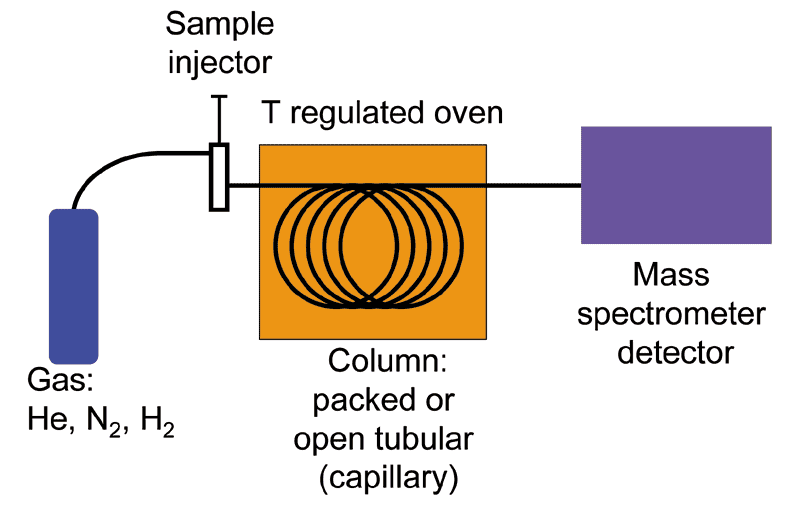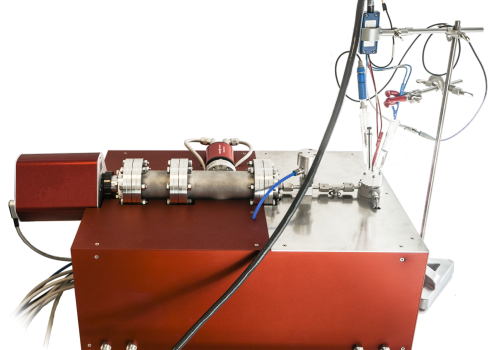Gas Chromatography-Mass Spectrometry - GC-MS - compared with EC-MS
Understanding Gas Chromatography–Mass Spectrometry (GC-MS)
Introduction to GC-MS
Gas Chromatography–Mass Spectrometry (GC-MS) is a powerful analytical technique used to identify and quantify compounds in a mixture. It combines two key technologies: gas chromatography (GC) and mass spectrometry (MS). This combination provides both the separation of compounds (GC) and their precise identification and quantification (MS).
Gas Chromatography (GC)
Gas chromatography involves the separation of compounds based on their volatilities and interactions with a stationary phase inside a column. The sample is vaporized and carried by an inert gas (mobile phase) through a column coated with a liquid or polymer (stationary phase). Different compounds travel through the column at different rates, leading to their separation.
Mass Spectrometry (MS)
Once separated, compounds enter the mass spectrometer. Here, they are ionized, typically by an electron beam, resulting in the fragmentation of molecules into charged particles (ions). These ions are then sorted based on their mass-to-charge ratio (m/z) using an electric or magnetic field. The resulting mass spectrum provides a unique fingerprint that helps identify and quantify the compounds.
Applications of GC-MS
GC-MS is widely used in various fields, including:
- Environmental Analysis: Detecting pollutants and contaminants in air, water, and soil.
- Pharmaceuticals: Analyzing the purity and composition of drugs.
- Food and Beverage: Ensuring the safety and quality of food products by identifying additives, pesticides, and contaminants.
- Forensics: Identifying substances in biological samples, such as drugs or poisons in toxicology reports.
Petrochemicals: Characterizing complex mixtures of hydrocarbons in fuels and oils.
Spectro Inlets’ Electrochemical Mass Spectrometry (EC-MS)
Introduction to EC-MS
Electrochemical Mass Spectrometry (EC-MS) from Spectro Inlets is an innovative technology that integrates electrochemistry with mass spectrometry. This system allows for real-time analysis of electrochemical reactions and gaseous products. While it shares some analytical capabilities with GC-MS, EC-MS is particularly suited for studying processes involving electrochemical reactions.
How EC-MS Works
The EC-MS setup typically consists of an electrochemical cell where the reactions occur and a mass spectrometer that analyzes the gaseous products generated. Key components include:
- Electrochemical Cell: This is where the electrochemical reactions take place. It usually contains a working electrode, a reference electrode, and a counter electrode.
- Mass Spectrometer: Similar to GC-MS, the mass spectrometer in EC-MS ionizes and detects gaseous products based on their mass-to-charge ratio.
- Interface: The connection between the electrochemical cell and the mass spectrometer is crucial for efficient transfer and analysis of the produced gases.
Applications of EC-MS
EC-MS is particularly useful for:
- Catalysis Research: Studying the mechanisms of electrochemical reactions on catalytic surfaces.
- Battery Research: Analyzing the gases evolved during battery operation and degradation.
- Fuel Cells: Monitoring the efficiency and by-products of fuel cell reactions.
- Corrosion Studies: Investigating the gases produced during corrosion processes.
Comparison with GC-MS
While GC-MS and EC-MS both provide powerful analytical capabilities, they cater to different types of analyses:
- GC-MS: Ideal for separating and identifying complex mixtures of volatile and semi-volatile compounds. Its strength lies in its ability to handle a wide range of sample types and provide detailed qualitative and quantitative data.
- EC-MS: Specialized for real-time analysis of gaseous products from electrochemical reactions. It excels in studying processes involving electrode surfaces, making it indispensable for electrochemical research.
Conclusion
Both GC-MS and EC-MS are invaluable tools in analytical chemistry, each serving distinct purposes. GC-MS is a versatile technique widely used for separating and identifying compounds in complex mixtures. In contrast, EC-MS from Spectro Inlets offers unique capabilities for real-time analysis of electrochemical reactions, providing insights into processes that are crucial for advancements in catalysis, energy storage, and corrosion science. Understanding the strengths and applications of these technologies allows researchers to choose the most appropriate method for their specific analytical needs.
See more about the EC-MS Professional:
See Our 3 different products:
In-depth GAS ANALYSIS FOR BATTERY RESEARCH
The Spectro Inlets EC-MS Premium enables real-time gas evolution measurements for battery research.
Effortless mass spectrometry for electrochemists
The Spectro Inlets EC-MS is a complete platform for mass spectrometry analysis of electrochemical reactions in real-time.
In-Line Process Monitoring for bio-manufacturing
The Spectro Inlets In-Line MS offers valuable real-time data on dissolved gases and volatiles in liquids during production processes.




